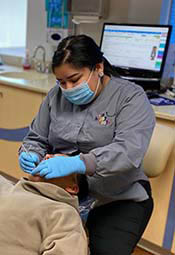Braces 101 – OK, so you have questions about getting braces, either for yourself or your child. Ever wish that someone would just publish a “Braces 101: What to Expect?” Or some sort of “Braces Survival Guide?”
You’re in luck! After decades of experience with braces and the people who wear them, we’ve fielded every question and heard every concern. So we got together some of our top orthodontists in the North Carolina area and had them answer some of the most frequently asked questions they’ve heard. Here’s the lowdown:
Braces 101: What to Expect
The one point all of our orthodontists bring up is that setting expectations is key to a successful treatment with braces.
- You should know what to expect going in, which means your orthodontist needs to do a good job communicating with you.
- He or she should cover what type of braces you need (for example, traditional braces vs. invisalign), how long the treatment will last, what the phases are, how much discomfort you can expect, and how much braces will cost you total.
- You should also review what to expect after you get your braces off, and whether or not you will need a retainer afterward.
Just to give you an example, a fairly typical braces treatment will look like this:
FIND AN OFFICE NEAR YOU GET OUR INVISALIGN DEAL
The Initial Braces Consultation
Before beginning any treatment, a good orthodontist will want to ask some questions to see whether braces are right for you. You should also get some idea of cost at this time.
The First Visit to Discuss Braces
The orthodontist will take x-rays of your mouth to create a 3-D model. This will help him or her choose the right hardware for you and outline a course of treatment. This may happen right after the initial consult, or it might be a separate appointment.
Putting The Braces On
Braces consist of wires attached to brackets that are glued to your teeth using a special dental cement. The process of putting them on takes a little less than two hours unless there is a complication, and the whole process is pretty painless.
Regular Check-ups for Braces
About once a month, you or your child will have to return to the orthodontist so he or she can check your mouth’s progress. During some of those check-ups, you will need to have your braces tightened.
Tightening the Braces
If your braces were positioned to move your teeth all at once, the pain would be unbearable and your mouth could get damaged. So, orthodontists use braces to move your teeth slowly and steadily, a little bit at a time. At the start of every new phase, your braces will need to be tightened so they can remain effective. A couple of days after getting your braces tightened is the time when you are most likely to experience some pain and discomfort.
Length of Braces Treatment
Treatment times vary, but 1 ½ to 3 years is common in both children and adults. (Adults tend to take a little longer, on average, because their mouths are more “set” and less pliable.)
Getting the Braces Off
Getting braces taken off is relatively painless, though it does take a little more force and can come with a “crunch” sound that is surprising if you are not ready for it. Ask about the process so you know what to expect!
Braces 101: Living with Braces
In between all of those visits to the orthodontist, you or your loved one will have to do things a little differently. This is part of living with braces. The changes are not hard, but they do mean picking up some new habits.
Taking Care of Those New Braces
Caring for braces, and for your teeth takes a little getting used to. For example, you will need to learn how to brush and floss so that food does not remain stuck and cause tooth decay.
Choosing Smart Food With Braces
You will also want to limit some foods during treatment with braces. You will want to avoid foods that:
- Can potentially stick to braces, or stick in the wires,
- Hard foods (like hard candy) that could break the hardware, and
- Tough or chewy foods (like beef jerky)
You might want to take this chance to improve your diet as well. You can substitute some of the foods above with foods that strengthen tooth enamel, for example.
(Get more details on what foods to eat and which foods to avoid.)
Dealing with Occasional Pain
Most orthodontists try to make braces as pain-free as possible. Still, if we are being realistic, you will experience some pain or discomfort at some point. That means that your braces are doing their job!
There are many things you can do to manage the pain, however. Frozen treats can numb your mouth, as well as an over-the-counter topical analgesic (like Anbesol). Over-the-counter painkillers, like ibuprofen, work well too (in moderate doses).
If you experience irritation at certain areas, it could mean that a wire or bracket edge is causing problems. A little dental wax can work wonders to stop this. We’ve also heard people say to avoid acidic drinks, like orange juice, as they can further irritate these areas.
Get A FREE BRACES CONSULTATION
Braces 101: Further Questions
Do you have further questions about braces that we did cover in this Braces 101 Guide? No problem– our orthodontists here at MyOrthodontist would love to answer them. You can either view the other articles on our Tooth Wisdom blog or schedule an appointment to speak with an orthodontist in person.


